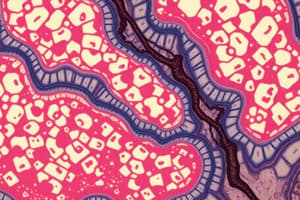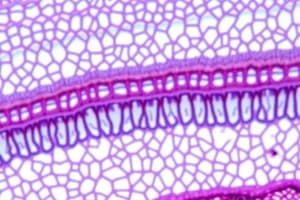Podcast
Questions and Answers
What is the primary function of homeostasis in the body?
What is the primary function of homeostasis in the body?
- To manage energy consumption
- To maintain a stable internal environment (correct)
- To enhance the effect of external stimuli
- To regulate the growth of tissues
Which component is NOT part of the homeostasis regulatory mechanism?
Which component is NOT part of the homeostasis regulatory mechanism?
- Stimulus Modifier (correct)
- Effector
- Receptor
- Control Center
What does negative feedback accomplish in the body?
What does negative feedback accomplish in the body?
- Stimulates the release of hormones
- Increases the intensity of the stimulus
- Promotes continuous change in the body
- Brings the body back to its normal range (correct)
How does extrinsic regulation differ from autoregulation?
How does extrinsic regulation differ from autoregulation?
Which statement correctly describes positive feedback?
Which statement correctly describes positive feedback?
What is the main function of neuroglia?
What is the main function of neuroglia?
Which part of the neuron is primarily responsible for receiving incoming signals?
Which part of the neuron is primarily responsible for receiving incoming signals?
What role do the mitochondria play in neurons?
What role do the mitochondria play in neurons?
How many axons does a typical neuron possess?
How many axons does a typical neuron possess?
What is NOT a function of neuroglia?
What is NOT a function of neuroglia?
Which structure of the neuron is responsible for conducting information to other cells?
Which structure of the neuron is responsible for conducting information to other cells?
What is contained within the cell body of a neuron?
What is contained within the cell body of a neuron?
What component of neural tissue helps to maintain the physical structure of tissues?
What component of neural tissue helps to maintain the physical structure of tissues?
What is the primary characteristic of simple epithelium?
What is the primary characteristic of simple epithelium?
Which gland releases hormones into the interstitial fluid without using ducts?
Which gland releases hormones into the interstitial fluid without using ducts?
What is NOT a function of connective tissue?
What is NOT a function of connective tissue?
Which type of connective tissue proper has more ground substance and fewer fibers?
Which type of connective tissue proper has more ground substance and fewer fibers?
What characterizes dense connective tissues compared to loose connective tissues?
What characterizes dense connective tissues compared to loose connective tissues?
What is the majority of tissue volume in connective tissue made up of?
What is the majority of tissue volume in connective tissue made up of?
Which connective tissue category focuses primarily on structural strength?
Which connective tissue category focuses primarily on structural strength?
What is a key feature of exocrine glands?
What is a key feature of exocrine glands?
What is the primary function of red blood cells?
What is the primary function of red blood cells?
What role do platelets play in the circulatory system?
What role do platelets play in the circulatory system?
Which of the following formed elements is primarily involved in the immune response?
Which of the following formed elements is primarily involved in the immune response?
What type of fluid is lymph?
What type of fluid is lymph?
Which cells are categorized as phagocytes?
Which cells are categorized as phagocytes?
The majority of the volume of whole blood is made up of which component?
The majority of the volume of whole blood is made up of which component?
What distinguishes lymphocytes from other white blood cells?
What distinguishes lymphocytes from other white blood cells?
What is the primary component of blood that gives it color?
What is the primary component of blood that gives it color?
What is the set point for body temperature regulation in the hypothalamus?
What is the set point for body temperature regulation in the hypothalamus?
Which physiological response occurs when body temperature exceeds 37.2°C?
Which physiological response occurs when body temperature exceeds 37.2°C?
What type of feedback mechanism is involved in blood clotting?
What type of feedback mechanism is involved in blood clotting?
How do damaged cells in a blood vessel initiate clotting?
How do damaged cells in a blood vessel initiate clotting?
What defines homeostasis in physiological systems?
What defines homeostasis in physiological systems?
What is the consequence if physiological systems fail to maintain balance?
What is the consequence if physiological systems fail to maintain balance?
What role do soluble proteins in blood play during the clotting process?
What role do soluble proteins in blood play during the clotting process?
What happens as the blood clotting process continues?
What happens as the blood clotting process continues?
Flashcards are hidden until you start studying
Study Notes
Epithelial Tissue Classification
- Simple epithelium consists of a single layer of cells.
- Stratified epithelium has multiple layers of cells.
- Glandular epithelia include:
- Endocrine glands: secrete hormones into interstitial fluid without ducts.
- Exocrine glands: produce secretions onto epithelial surfaces through ducts.
Connective Tissue Characteristics
- Contains specialized cells, solid extracellular protein fibers, and fluid extracellular ground substance.
- The matrix, composed of fibers and ground substance, determines the tissue's specialized function and makes up most of its volume.
Functions of Connective Tissue
- Establishes structural framework for the body.
- Transports fluids and dissolved materials.
- Protects delicate organs.
- Supports and interconnects other tissue types.
- Stores energy reserves (mainly triglycerides).
- Defends against invading microorganisms.
Classification of Connective Tissues
- Connective tissue proper: connects and protects.
- Fluid connective tissues: involved in transport.
- Supporting connective tissues: provide structural strength.
Categories of Connective Tissue Proper
- Loose connective tissue: more ground substance with fewer fibers (e.g., areolar tissue, adipose tissue).
- Dense connective tissue: more fibers with less ground substance (e.g., tendons).
Fluid Connective Tissues
- Blood and lymph are examples, possessing a watery matrix rich in dissolved proteins.
- Formed elements of blood consist of:
- Red blood cells (erythrocytes): transport oxygen and carbon dioxide, constituting about half the blood volume.
- White blood cells (leukocytes): defend against infections.
- Platelets: membrane-enclosed cell fragments essential for blood clotting.
Lymphatic System
- Lymph is extracellular fluid collected from interstitial spaces, monitored by the immune system, and transported by the lymphatic system.
Neural Tissue
- Neuroglia are supporting cells that maintain physical structure, assist in repair, and provide nutrients to neurons.
- Neurons consist of the cell body (with nucleus and nucleolus), dendrites (which receive signals), and axon (which transmits electrical signals).
Organs and Systems
- An organ is composed of two or more tissue types serving different functions; skin, the largest organ, contains all four primary tissue types.
- Organ systems group related organs to perform specific functions.
Homeostasis
- Homeostasis maintains a stable internal environment through cooperation of body systems.
- Internal and external changes trigger responses to keep parameters (like body temperature) within normal ranges.
Mechanisms of Regulation
- Autoregulation (intrinsic): automatic responses in cells or tissues to environmental changes.
- Extrinsic regulation: responses managed by nervous and endocrine systems.
Feedback Mechanisms
- Negative feedback: effector responses negate the stimulus, restoring homeostasis. Example: temperature regulation by hypothalamus.
- Positive feedback: effector responses amplify the stimulus, moving the body away from homeostasis to speed processes. Example: blood clotting process intensifies until a clot is formed.
Systems Integration
- Multiple physiological systems collaborate to uphold homeostasis, maintaining dynamic equilibrium.
- Disruption of balance can result in disease or death.
Studying That Suits You
Use AI to generate personalized quizzes and flashcards to suit your learning preferences.




